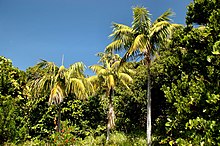Lord Howe long-eared bat
| Lord Howe long-eared bat | |
|---|---|
| Scientific classification | |
| Domain: | Eukaryota |
| Kingdom: | Animalia |
| Phylum: | Chordata |
| Class: | Mammalia |
| Order: | Chiroptera |
| Family: | Vespertilionidae |
| Genus: | Nyctophilus |
| Species: | †N. howensis
|
| Binomial name | |
| †Nyctophilus howensis | |

| |
| Location of Lord Howe Island | |
The Lord Howe long-eared bat (Nyctophilus howensis) was a
Taxonomy
The taxon was published by John McKean in 1975 as a new species of the genus Nyctophilus.[2] A revision of the genus (Parnaby, 2009), proposed that a reassessment of the status might separate this species to a new genus.[3] The placement with genus Nyctophilus was regarded as an indefinite arrangement, being limited by a single and incomplete specimen of an unobserved species.[4]
The
Common names include Lord Howe island bat.[6] The specific epithet combines 'Howe', the island named for Richard Howe, and ensis to mean 'inhabiting that place'.[7]
Description
The species describes a vespertilionid bat, akin to the 'large-eared' species of Nyctophilus and
The only specimen is an almost complete skull, of unknown gender, missing some teeth and the
Ecology

Almost no information on the species is available, the biology and ecology is presumed to be similar to associated species. The skull was obtained in a cave at the island, as a modern deposit of material, and this the only physical source of information. The determined age of the specimen, near contemporary (20th century), suggested the unreported group had disappeared recently.[4] The small island is a relic of an eroded volcano, approximately 600 kilometres east of the Australian continent, with unique subtropical vegetation assemblages. The flora and fauna is related to that of Australia, yet presenting a high degree of endemism, and Lord Howe has been inhabited by at least two other bats. Nyctophilus howensis is presumed to have descended from wind-blown bats from the nearby continent.[9]
An insectivorous flying mammal population, a

It is presumed
References
- ^ .
- ^ S2CID 254725278.
- ^ .
- ^ ISBN 9780195573954.
- ^ ISBN 9781486300136.
- ^ a b "Species Nyctophilus howensis McKean, 1975 Lord Howe Island Bat, Lord Howe Long-eared Bat". Australian Faunal Directory. Retrieved 24 January 2019.
- ISBN 9780643100060.
- ^ ISBN 9780643103740.
- ^ Daniel, M.J.; Williams, G.R. (1984). "A survey of the distribution, seasonal activity and roost sites of New Zealand bats" (PDF). New Zealand Journal of Ecology. 7: 9–25.
- ^ Department of Environment and Climate Change (NSW) (2007). Lord Howe Island Biodiversity Management Plan (PDF) (Report). Sydney: Department of Environment and Climate Change (NSW). p. 24.
- ^ "Nyctophilus howensis Species Account". Mammal Diversity Database. American Society of Mammalogists. Retrieved 23 January 2019.
- ^ "A Five-Year Plan for Global Bat Conservation" (PDF). batcon.org. Bat Conservation International. October 2013. Archived from the original (PDF) on 17 April 2018. Retrieved 1 May 2017.
- .

